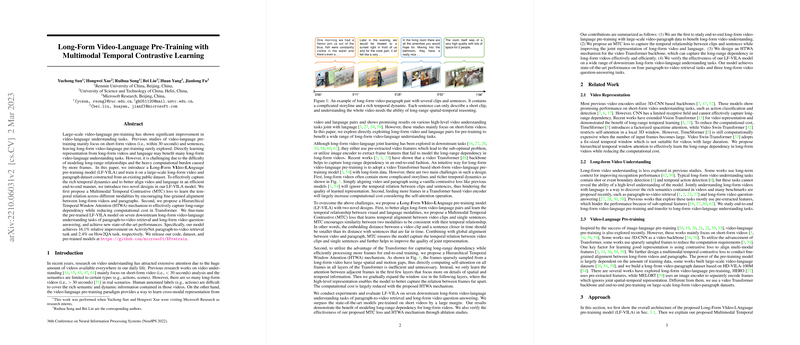Long-Form Video-Language Pre-Training with Multimodal Temporal Contrastive Learning
The paper "Long-Form Video-Language Pre-Training with Multimodal Temporal Contrastive Learning" introduces an innovative approach to enhance the understanding of long-form video-language tasks. Unlike previous methods that focus predominantly on short-form videos (less than 30 seconds), this work specifically addresses the complexities inherent in long-form video content that extends beyond 30 seconds. The proposed Long-Form VIdeo-LAnguage pre-training model (LF-VILA) aims to leverage the richer semantics and temporal dynamics of extended videos, which are often overlooked in existing research.
The LF-VILA model incorporates two novel components: Multimodal Temporal Contrastive (MTC) loss and Hierarchical Temporal Window Attention (HTWA). These components are designed to address the challenges of aligning long-form videos and language representations while efficiently managing computational resources.
Main Contributions
- Multimodal Temporal Contrastive Loss: The MTC loss facilitates fine-grained temporal alignment between video segments and the corresponding paragraph descriptions. It ensures that the temporal closeness of video clips and sentences is reflected in their embedding distances, enhancing the quality of learned representations. By influencing both clip-to-sentence and sentence-to-clip alignments, the MTC loss augments the model's capability to understand the narrative structure of videos.
- Hierarchical Temporal Window Attention: To efficiently capture long-range dependencies without overwhelming computational costs, the authors introduce HTWA. This mechanism progressively enlarges the temporal attention window across the layers of the video Transformer, allowing for both local and global temporal reasoning. This hierarchical approach optimizes the balance between model complexity and performance.
- State-of-the-Art Results: The LF-VILA demonstrates superior performance on multiple long-form video-language tasks. Notably, it achieves remarkable improvements on the ActivityNet paragraph-to-video retrieval task and the How2QA task, surpassing existing models by 16.1% and 2.4%, respectively, in relative performance.
Implications and Future Directions
The results suggest that the LF-VILA model significantly benefits from long-range temporal modeling and enhanced video-paragraph alignment. This advancement has practical implications for tasks such as paragraph-to-video retrieval and video question-answering, highlighting the model's potential to transform the handling of more complex video data. Theoretically, these findings enrich the ongoing discourse around video-language understanding by demonstrating the utility of contrastive learning strategies in multimodal contexts.
Future research could explore the extension of this framework to more diverse datasets or adapt it for real-time applications where computational efficiency remains a priority. Additionally, investigating the integration of external multimodal datasets could further enhance understanding and uncover new applications in automated video summarization and enhanced content recommendation systems.
Conclusion
The paper presents a substantial advancement in the field of video-language understanding by effectively pre-training models on long-form content using innovative loss functions and attention mechanisms. This work not only addresses existing gaps in the literature but also sets a new benchmark for future research in seamlessly integrating language and video data at scale.
